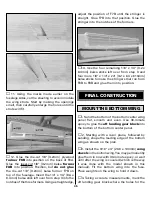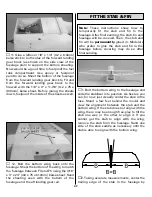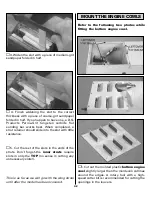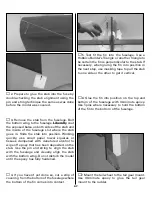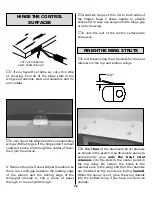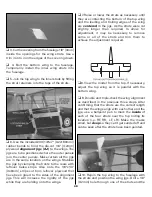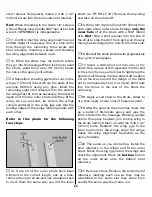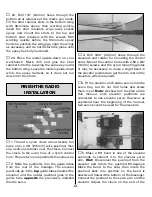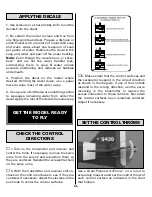
1/2" [15mm] overlap is suggested. Lastly, the
red, white and blue were applied to the rudder
as though it were one piece of covering. Use
care not to heat the overlapping seams while
heating the rest of the covering. Otherwise, the
adhesive on the covering will soften, and the
seam may pull apart as the covering tightens.
Don’t forget to leave part of the rudder exposed
for gluing on the tail wheel mount.
❏
5. The fuselage is a little trickier to cover than
it may appear. However, it can be simplified by
covering it in several sections rather than
attempting to do each side in just one or two
pieces. Start with the white band (scuffed with
600-grit sandpaper first), then cover the fuse aft
of the stripe. Cover the rest of the fuselage in
small sections as shown in the photo.
❏
6. Cover the aileron servo hatches.
❏
7. Cover the “corners” and the side of rib R4A
in the wings where the ailerons fit.
❏
8. Cover the bottom of the wings, but
do not
yet cover the top of the wings. Before covering
the tops, route a “Y” connector through the
holes in the ribs in both wings. Connect the “Y”
connectors to the aileron servo wires, then
mount the servo hatches to the wing. Secure
the connections between the “Y” connector and
the servo wires with heat shrink tubing, tape or
clips intended for that purpose. Also cut a hole
through the sheeting in the top of the bottom
wing for the Y-connector to exit (the hole in the
top wing for the “Y” connector will be cut later).
Now you may cover the tops of the wings and
proceed to the ailerons.
❏
1. Now that the model has been covered, use
epoxy or fuelproof paint to fuelproof areas of
unprotected wood that will be exposed to fuel
or exhaust residue such as the inside of the
engine compartment and partway down into
the radio compartment inside the fuselage
(including the fuselage sides, the back of former
F3 and the front of former F5). Also fuelproof
the grooves in the landing gear blocks if they
are not already sealed by the covering.
❏
2. Cut out the molded plastic
head rest
leaving about a 3/16" [5mm] “flange” around
the bottom. Cut out the molded plastic
right
and
left exhaust pipes
. Use coarse sandpaper
to sand the exhaust pipes so they will lie flat.
PAINTING
45
Summary of Contents for Dynaflite S.E.5a
Page 9: ...9 Die Drawing...
Page 10: ...10 Die Drawing...





